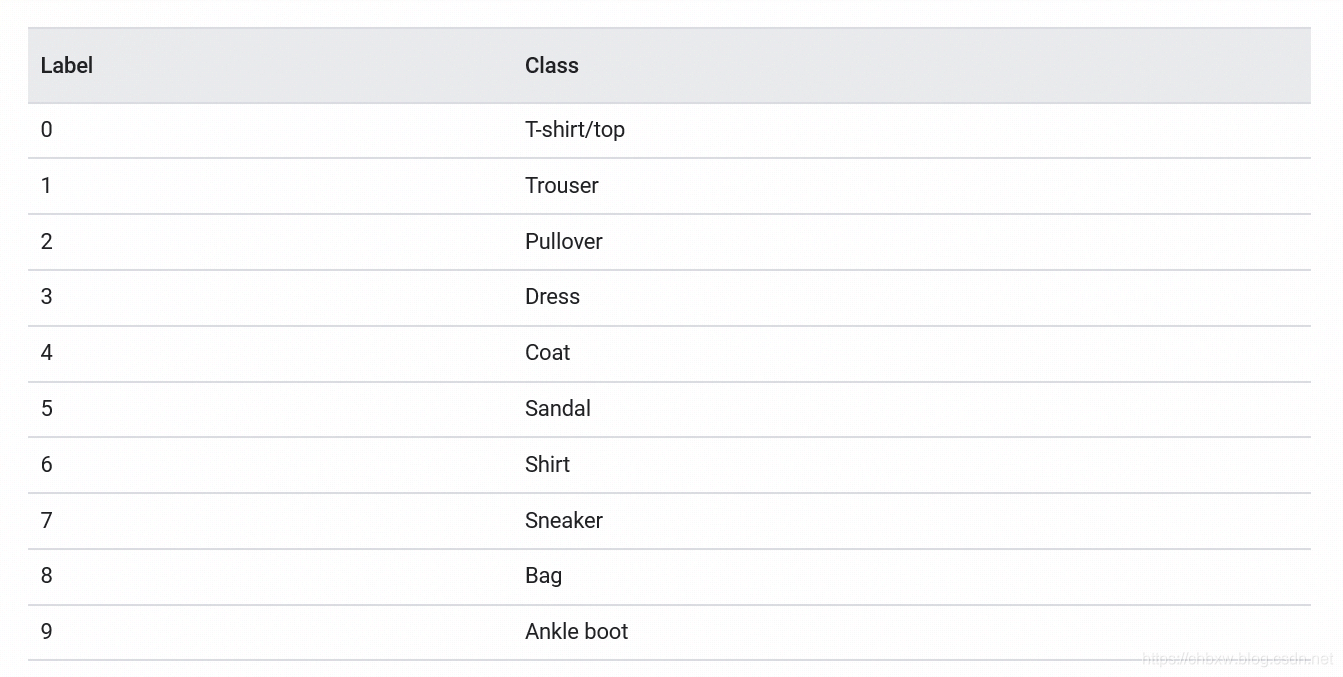参考tensorflow2.0官网图像分类教程:https://tensorflow.google.cn/tutorials/keras/classification
一、数据集
1.1、Fashion MNIST介绍
该数据集包含10个类别中的70,000个灰度图像。 图像显示了低分辨率(28 x 28像素)的单件服装
1.2、导入数据集
import tensorflow as tf
from tensorflow import keras
import numpy as np
import matplotlib.pyplot as plt
print(tf.__version__)
print(keras.__version__)
# 导入fashion MNIST 数据集
fashion_mnist = keras.datasets.fashion_mnist
# 训练集、训练标签;测试集、测试标签
(train_images, train_labels), (test_images, test_lables) = fashion_mnist.load_data()
print(train_images.shape) # (60000, 28, 28)
print(train_labels.shape) # (60000,)
print(test_images.shape) # (10000, 28, 28)
print(test_lables.shape) # (10000,)图像是28x28 NumPy数组,像素值介于0到255之间。标签是一个整数数组,范围从0到9.这些对应于图像所代表的服装类别:

标签类名:
class_names = ['T-shirt/top', 'Trouser', 'Pullover', 'Dress', 'Coat',
'Sandal', 'Shirt', 'Sneaker', 'Bag', 'Ankle boot']
查看图像
plt.figure()
plt.subplot(1, 2, 1)
plt.imshow(train_images[0])
plt.colorbar()
plt.grid(False)
# 归一化, 像素值都在0~255
train_images = train_images / 255.0
test_images = test_images / 255.0
plt.subplot(1, 2, 2)
plt.imshow(train_images[0], cmap=plt.cm.binary)
plt.colorbar()
plt.grid(False)
plt.show()
验证数据集标签的正确性,查看一下前25张图片,将标签显示在图片的下方

二、建模
2.1、构造层(set up layers)
神经网络的基本构件是层(layer),层从输入数据提取表现(representations), 希望这些表现能够对现有问题有所帮助。
很多深度学习有许多简单的层链接在一起的,许多层拥有在训练中学习的参数,例如tf.keras.layers.Dense。
model = keras.Sequential([
keras.layers.Flatten(input_shape=(28, 28)),
keras.layers.Dense(128, activation='relu'),
keras.layers.Dense(10, activation='softmax')
])第一层,转换图像格式: 将二维(28*28)的图像数组转为一维(28*28=784), 这层没有学习参数,只是格式数据。
在像素被压平(flatten)之后,接下来是两个keras.layers.Dense层,它们是紧密连接、或完全连接的神经层。
第二层,128个节点(nodes or neurons) 。
第三层,10个节点的softmax层, 输出10个可能的分数,加在一起和为1,表示10个分类的可能性分数
激活函数:relu,softmax
2.2、编译模型(Compile the model)
在训练模型前,有一些设置需要在编译模型:
- Loss function —This measures how accurate the model is during training. You want to minimize this function to “steer” the model in the right direction.
- Optimizer —This is how the model is updated based on the data it sees and its loss function.
- Metrics —Used to monitor the training and testing steps. The following example uses accuracy, the fraction of the images that are correctly classified.
# 编译模型
model.compile(optimizer='adam',
loss='sparse_categorical_crossentropy',
metrics=['accuracy'])三、训练模型
训练神经网络模型需要以下步骤:
扫描二维码关注公众号,回复:
8539208 查看本文章


- 1、将训练数据输入模型, 本例中的图像和标签
- 2、模型学习将图像和标签联系起来
- 3、通过测试集验证模型的准确性
3.1、训练
# 训练模型
model.fit(train_images, train_labels, epochs=10)
模型训练中,显示loss,accuracy
56352/60000 [===========================>..] - ETA: 0s - loss: 0.2497 - accuracy: 0.9059
57024/60000 [===========================>..] - ETA: 0s - loss: 0.2501 - accuracy: 0.9057
57760/60000 [===========================>..] - ETA: 0s - loss: 0.2500 - accuracy: 0.9059
58528/60000 [============================>.] - ETA: 0s - loss: 0.2496 - accuracy: 0.9059
59264/60000 [============================>.] - ETA: 0s - loss: 0.2501 - accuracy: 0.90573.2、评估准确性
# 评估模型, 使用测试集评估
test_loss, test_acc = model.evaluate(test_images, test_labels, verbose=2)
print('\nTest accuracy:', test_acc)
# 10000/1 - 1s - loss: 0.2630 - accuracy: 0.8757
# Test accuracy: 0.8757四、预测
# 预测
predictions = model.predict(test_images)
print(predictions[0]) # 10个评分,表示10个分类的可能性
# [3.1136313e-08 3.8150518e-09 1.1725315e-10 9.5243632e-11 1.9169266e-10
# 6.1769143e-04 2.1648395e-08 3.2574847e-02 2.0015452e-07 9.6680719e-01]
# 预测值与标签值
print(np.argmax(predictions[0]), test_labels[0]) # 9, 9
4.2、通过绘制图像显示10个分类
def plot_image(i, predictions_array, true_label, img):
predictions_array, true_label, img = predictions_array, true_label[i], img[i]
plt.grid(False)
plt.xticks([])
plt.yticks([])
plt.imshow(img, cmap=plt.cm.binary)
predicted_label = np.argmax(predictions_array)
if predicted_label == true_label:
color = 'blue'
else:
color = 'red'
plt.xlabel("{} {:2.0f}% ({})".format(class_names[predicted_label],
100*np.max(predictions_array),
class_names[true_label]),
color=color)
def plot_value_array(i, predictions_array, true_label):
predictions_array, true_label = predictions_array, true_label[i]
plt.grid(False)
plt.xticks(range(10))
plt.yticks([])
thisplot = plt.bar(range(10), predictions_array, color="#777777")
plt.ylim([0, 1])
predicted_label = np.argmax(predictions_array)
thisplot[predicted_label].set_color('red')
thisplot[true_label].set_color('blue')
4.2.1、显示第一个图像
正确预测标签显示蓝色,错误预测标签显示红色
i = 0
plt.figure(figsize=(6,3))
plt.subplot(1,2,1)
plot_image(i, predictions[i], test_labels, test_images)
plt.subplot(1,2,2)
plot_value_array(i, predictions[i], test_labels)
plt.show()
4.2.2、显示更多图片的预测
num_rows = 5
num_cols = 3
num_images = num_rows*num_cols
plt.figure(figsize=(2*2*num_cols, 2*num_rows))
for i in range(num_images):
plt.subplot(num_rows, 2*num_cols, 2*i+1)
plot_image(i, predictions[i], test_labels, test_images)
plt.subplot(num_rows, 2*num_cols, 2*i+2)
plot_value_array(i, predictions[i], test_labels)
plt.tight_layout()
plt.show()
